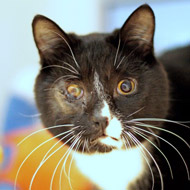
44 per cent of vets have treated cats wounded by air guns
There has been a major demand for air gun licencing in England and Wales, as a result of the increase in fatal attacks on cats, in recent years.
Leading feline welfare charity, Cats Protection, commissioned a survey of 1,000 vets, revealing a decrease in air gun attacks but an increase in the fatality rates of these attacks, compared with 20 years ago.
The survey showed that 44 per cent of vets had treated cats wounded by air guns and around half of those cats died as a result of their injuries.
This rise in fatalities implies that more powerful air guns are being used, with most injuries being inflicted to the head and torso, leaving many cats blind or partially sighted.
The survey also revealed that over the past 12 months, vets in the North West and South East of England treated the highest number of shot cats, with both seeing an average of 100 cases.
Cats Protection’s advocacy manager Jacqui Cuff said: “The sheer volume of instances where cats are injured and killed by air gun attacks is very concerning.
“We are calling for much stricter regulation on the ownership of air guns, as we strongly believe this will help to protect cats and other animals from these shocking attacks, and avoid air guns falling into the wrong hands. We want to see England and Wales following the example of Scotland, where from next year it will be illegal to own an air gun without a licence…”
Jacqui added: “If any cat owners have lost their cat to an air gun attack in the last six months we’d be grateful if they could send any details to campaigns@cats.org.uk. It will help Cats Protection to collect more evidence about the scale of these attacks and continue to raise the issue with politicians across the UK.”
The Cats Protection Survey also revealed that 88 per cent of those shooting cats with air guns are aged 24 years or younger. The discovery is especially worrying following comments from a leading criminologist, who warned of the correlation between those who injure and kill animals and those who go onto commit similar crimes against humans.
Dr Adam Lynes, criminologist and lecturer at Birmingham City University comments: “There is an increasing body of research that examines the relationship between animal cruelty and the move towards attacking and murdering humans.
“It is argued that through the process of social learning theory (a theoretical framework in which criminal behaviour is learned) that some offenders will gain positive stimuli from engaging in animal cruelty which may lead to aggression towards humans – this is known as the ‘graduation hypothesis’.
“While it is acknowledged that a crime such as serial murder is incredibly rare, this relationship between animal cruelty and aggression towards humans may explain why some individuals commit acts of violence towards animals prior to attacking humans.”
A ‘keeping cats safe’ information leaflet can be downloaded from Cats Protection’s website at http://www.cats.org.uk/cat-care/care-leaflets/essential-guides
Image (C) Cats Protection



 The RCVS has announced a new version of its 1CPD mobile app, with enhanced features for veterinary surgeons and veterinary nurses to record their continuing professional development.
The RCVS has announced a new version of its 1CPD mobile app, with enhanced features for veterinary surgeons and veterinary nurses to record their continuing professional development.